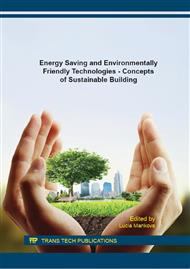p.379
p.387
p.395
p.403
p.411
p.421
p.429
p.437
p.445
The Effect of the Vegetative Roof Construction and the Influence of the Effect of the Designed Air Gap on the Thermal Stability in the Testing Building
Abstract:
The article deals with building physical behavior of the pitched vegetative turf roof with inclination of 25°, the vegetative layer is composed of the turf carpets. This paper is focused on possible constructional solutions of the pitched vegetative roof and on the thermal stability and increasing temperature during the summer period in the testing building. The important part of this survey concerns of designing and the efficient influence of the ventilated or unventilated air gap on the inner environment and stability of the roof construction.
Info:
Periodical:
Pages:
411-420
Citation:
Online since:
January 2016
Authors:
Price:
Сopyright:
© 2016 Trans Tech Publications Ltd. All Rights Reserved
Share:
Citation:


